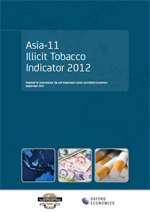Ungated Post | 26 Sep 2013
Asia-11 Illicit Tobacco Indicator 2012

This report, prepared by ITIC (www.ITICnet.org) and Oxford Economics, provides an overview of the nature of the illicit trade of cigarettes across 11 selected Asian markets (including Australia), and establishes credible estimates of consumption of illicit cigarettes and the impact this has on tobacco tax revenue in each of the countries. Total consumption (legal and illicit) across the Asia-11 markets covered in this report totalled an estimated 736.4 billion cigarettes in 2012, of which 9% or 66.5 billion cigarettes are estimated to have been illicit. Illicit consumption of cigarettes resulted in a tax revenue loss for Asia-11 governments totalling US$ 3.4 billion in 2012.
Oxford Economics’ team is expert at applying advanced economic tools that provide valuable insights into today’s most pressing business, financial, and policy issues.
To find out more about our capabilities, contact:
Americas
Diantha Redd
+1 (646) 503 3052
Email
Asia Pacific
Peter Suomi
+65 6850 0110
Email
EMEA
Aoife Pearson
+44 (0)203 910 8054
Email
Related Services

Post
Global Trade Education: The role of private philanthropy
Global trade can amplify economic development and poverty alleviation. Capable leaders are required to put in place enabling conditions for trade, but currently these skills are underprovided in developing countries. For philanthropists, investing in trade leadership talent through graduate-level scholarships is an opportunity to make meaningful contributions that can multiply and sustain global economic development.
Find Out More
Post
Mapping the Plastics Value Chain: A framework to understand the socio-economic impacts of a production cap on virgin plastics
The International Council of Chemical Associations (ICCA) commissioned Oxford Economics to undertake a research program to explore the socio-economic and environmental implications of policy interventions that could be used to reduce plastic pollution, with a focus on a global production cap on primary plastic polymers.
Find Out More
Post
The Economic Contribution of Mexico’s Audiovisual Industry
This report demonstrates the integral role that the AV industry plays in Mexico's economy by estimating the industry’s domestic economic footprint. The analysis comprises all aspects of the audiovisual industry, including film production, distribution, and exhibition; the production, distribution, and broadcast of television content on free-to-air and pay TV channels; and online video platforms. Our estimates provide a recent snapshot of the audiovisual industry, including impacts at the broader industry level and broken out by sub-sector.
Find Out More